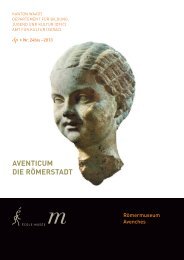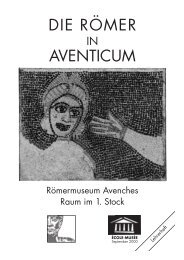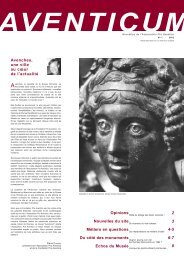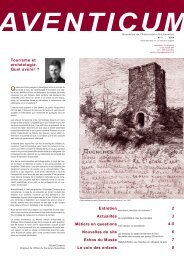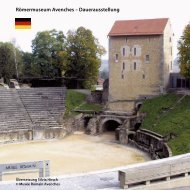Avenches – Roman Museum – Permanent Exhibition
Avenches – Roman Museum – Permanent Exhibition
Avenches – Roman Museum – Permanent Exhibition
Create successful ePaper yourself
Turn your PDF publications into a flip-book with our unique Google optimized e-Paper software.
Ground Floor The Gallo-<strong>Roman</strong> Population of Switzerland and Their View of Death<br />
The Extraordinary Finds at the Necropolis of En Chaplix<br />
statues indicate that this Silenus was depicted in a resting pose with legs crossed and<br />
his head turned to the right. He wears a crown of ivy leaves and flowers. Like in the case<br />
of the Satyr carrying the Child Bacchus, the movement of the Silenus’ head and the<br />
rapturous expression in his face point to an Hellenistic model (3rd <strong>–</strong> 2nd centuries BC). The<br />
Silenus statue, which stood in the funerary garden of a necropolis, symbolises carefree<br />
life after death.<br />
Fragment of limestone statue, belonging to the northern En Chaplix monument. Around<br />
AD 30.<br />
11. Nereid Bust<br />
The Nereids are sea deities, daughters of Nereus, the Old Man of the Sea. Of this group<br />
only the bust of the Nereid from the upper block and a fragment of Triton’s fish tail<br />
belonging to the lower part are preserved. Regarding the model and the symbolic<br />
meaning, please refer to the group on the right (no. 12), which is better preserved.<br />
Limestone. Group situated in the upper left-hand corner of the façade of the northern En<br />
Chaplix monument. Around AD 30.<br />
12. Triton Seizing a Nereid (1)<br />
Tritons are sea deities. Their upper bodies have human form while they are fish-shaped<br />
from the stomach down. They belong to the retinue of Neptune, the God of the Sea. In<br />
this case, a Triton is using both his hands to pin down a terrified Nereid on his fish tail. Her<br />
coat is billowing in the wind.<br />
Models for the Triton and Nereid group can be found in the Hellenistic period<br />
(3rd <strong>–</strong> 2nd centuries BC). The motif is often used for funerary decorations, in particular on<br />
sarcophagi. The sea creature theme symbolises blissful and carefree life after death.<br />
Made of limestone, this group was placed in the upper right-hand corner of the façade of<br />
the northern En Chaplix monument. Around AD 30.<br />
The Southern Monument<br />
The second monument was modelled on the same pattern as the first. Built on more<br />
stable ground it did not require the use of piles, so this monument cannot be dated<br />
as precisely as the first one.<br />
The very similar decoration is better preserved. In the upper part of the base,<br />
the Nereids are carried by griffins instead of Tritons. On the pedestal, two so-called<br />
”dancing“ Attis statues, followed by a clipeus (circular decorative motif), may have<br />
once framed the lost inscription.<br />
A man wearing a toga, flanked by a second man and a woman was depicted in<br />
the middle of the square column-framed aedicule. The pointed, square shaped roof<br />
ended in a pinecone symbolising immortality.<br />
13. Male Portrait (2)<br />
The preserved fragments allow for the restitution of the statue as depicting one of<br />
the deceased, represented as a <strong>Roman</strong> citizen wearing a toga and holding a scroll<br />
(volumen); at his feet lies a box (scrinium) containing other scrolls. Holes in his forehead<br />
indicate that he wore a metal crown, which, however, was lost. The hairstyle with curls is<br />
inspired by representations of emperor Tiberius (AD 14 <strong>–</strong> 37). The realistic features of his<br />
face correspond to the concept of expressive art prevailing at the end of the Republic<br />
(1st century BC). This very carefully executed effigy is one of only a small number of<br />
1<br />
2<br />
15<br />
Ground Floor



